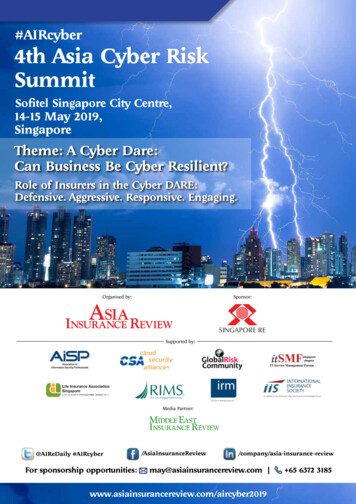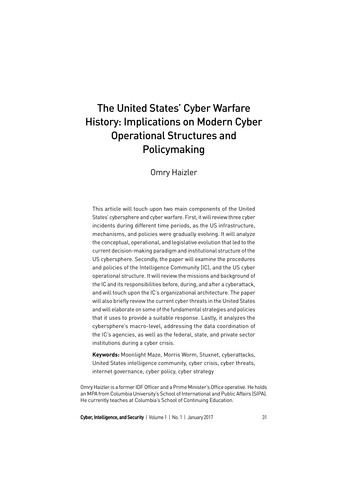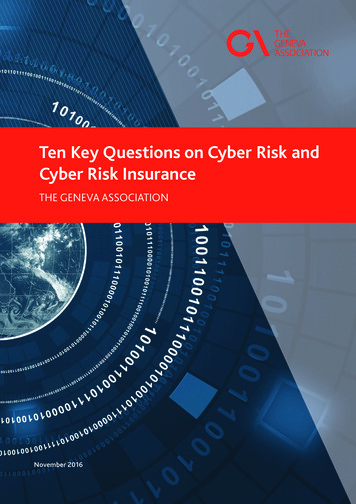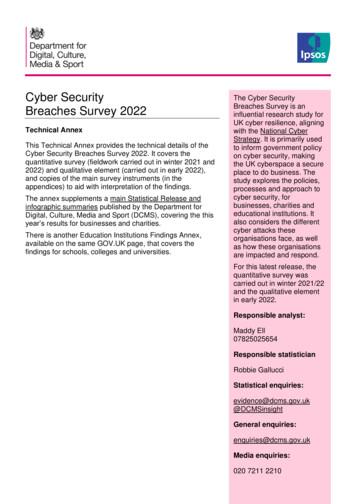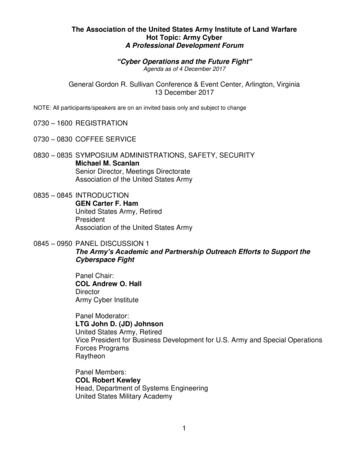
Transcription
The Association of the United States Army Institute of Land WarfareHot Topic: Army CyberA Professional Development Forum“Cyber Operations and the Future Fight”Agenda as of 4 December 2017General Gordon R. Sullivan Conference & Event Center, Arlington, Virginia13 December 2017NOTE: All participants/speakers are on an invited basis only and subject to change0730 – 1600 REGISTRATION0730 – 0830 COFFEE SERVICE0830 – 0835 SYMPOSIUM ADMINISTRATIONS, SAFETY, SECURITYMichael M. ScanlanSenior Director, Meetings DirectorateAssociation of the United States Army0835 – 0845 INTRODUCTIONGEN Carter F. HamUnited States Army, RetiredPresidentAssociation of the United States Army0845 – 0950 PANEL DISCUSSION 1The Army’s Academic and Partnership Outreach Efforts to Support theCyberspace FightPanel Chair:COL Andrew O. HallDirectorArmy Cyber InstitutePanel Moderator:LTG John D. (JD) JohnsonUnited States Army, RetiredVice President for Business Development for U.S. Army and Special OperationsForces ProgramsRaytheonPanel Members:COL Robert KewleyHead, Department of Systems EngineeringUnited States Military Academy1
COL John GiordanoJ5, Cyber National Mission ForceLTC Joshua BundtResearch ScientistArmy Cyber InstituteLTC Timothy D. BloechlUnited States Army, RetiredDirector, Cyber Security BusinessQuantum Research International & CyberDxNatasha CohenDirector, Cyber Policy and Client StrategyBlueteamGlobalDr. Daniel RagsdaleCOL, United States Army, RetiredDirector, Cybersecurity CenterTexas A&M UniversityChief Joseph PfeiferChief of Counterterrorism & Emergency PreparednessNew York City Fire DepartmentTyson B. MeadorsDirector for Cybersecurity PolicyNational Security Council0950 – 1000 KEYNOTE INTRODUCTIONLTG Paul M. NakasoneCommanding GeneralUnited States Army Cyber Command1000 – 1020 KEYNOTE SPEAKERGEN Raymond A. Thomas IIICommanderUnited States Special Operations Command1020 – 1050 REFRESHMENT BREAK1050 – 1200 PANEL DISCUSSION 2Cyber Electromagnetic Activities (CEMA) Support to Corps and BelowPanel Chair:COL (P) William J. HartmanDeputy Commander Joint Force HQ – Cyber (Army)United States Army Cyber Command2
Panel Moderator:LTG Richard FormicaUnited States Army, RetiredVice PresidentCalibre SystemsPanel Members:MG Gregg C. PotterUnited States Army, RetiredCorporate Lead Executive Northrop Grumman (Fort Meade/Aberdeen)Northrop GrummanMAJ(P) Wayne A. SandersBranch ChiefCEMA Support to Corps and BelowARCYBER G39MAJ Steven N. FeighMission Team Lead152nd Cyber Protection TeamUnited States Army Cyber Protection BrigadeCOL Robert M. RyanCommander, 3rd Brigade Combat Team25th Infantry DivisionCOL Adam C. VolantCommander, 91st Cyber Brigade andCommander, Task Force EchoArmy National Guard1200 – 1330 LUNCH (On Own, Concessions available in immediate area)1330 – 1430 PANEL DISCUSSION 3The Future Force Build and Integration of the Electronic Warfare andInformation Operations Fields into CyberPanel Co-Chairs:MG Patricia A. FrostDirector of CyberOffice of the Deputy Chief of Staff, G-3/5/7MG John B. Morrison, Jr.Commanding GeneralCyber Center of Excellence and Fort Gordon3
Panel Moderator:LTG Jeff SorensonUnited States Army, RetiredPresident and PartnerA.T. Kearney Public Sector & Defense Services, LLCPanel Members:BG Neil S. HerseyCommandantUnited States Army Cyber Center and SchoolCOL Paul “Tim” BrooksMission Assurance Division ChiefDepartment of the Army Management Office – CyberCOL Laurie BuckhoutUnited States Army, RetiredPresident and CEOCorvus GroupCOL George LewisUnited States Army, RetiredVice President - CEMA InitiativesCACI InternationalAnita PavadorePrincipal Research EngineerNetwork Vulnerability DivisionGeorgia Tech Research Institute1430 – 1435 CLOSING REMARKSLTG Paul M. NakasoneCommanding GeneralUnited States Army Cyber Command1435 – 1445 CLOSING REMARKSGEN Carter F. HamUnited States Army, RetiredPresidentAssociation of the United States Army1445DEPARTURE4
BIOGRAPHYGeneral Carter F. Ham, U.S. Army, RetiredGeneral Carter Ham is the President andChief Executive Officer of the Associationof the United States Army, a Virginiabased, private non-profit organization with121 chapters worldwide that acts primarilyas an advocacy group for the Army andits soldiers, families and retirees.General Ham retired from the UnitedStates Army in 2013 as the Commander,U.S. Africa Command where he traveledto 42 countries as part the Command'sefforts to enhance America’s security byestablishing and developing partnerships. He directed military operations, includingleading coalition forces during the Libyan conflict in 2011, hostage rescue operationsin Somalia and counter-terrorism operations across the African continent.Prior to leading AFRICOM, General Ham was the commander of all U.S. Army forcesin Europe, where he oversaw troops deployed to the Balkans, to Iraq and as part ofthe North Atlantic Treaty Organization mission in Afghanistan. He spent nearly fourdecades in the Army and is one of a very small number of military leaders who rosefrom the rank of Private to four-star General.General Ham served in various capacities both in the field and in the Pentagon. InJanuary 2004, he assumed command of Multinational Brigade (Task Force Olympia)– North in Mosul, Iraq serving there until February 2005. He commanded the FirstInfantry Division (the Big Red One) and, later, served as the Director of Operations,J3, at the Joint Staff. In retirement, he chaired the Congressionally-mandatedNational Commission on the Future of the Army.He is a 1976 Distinguished Military Graduate of John Carroll University in Cleveland,Ohio. General Ham earned a master’s degree from the Naval War College, Newport,Rhode Island. He and his wife, Christi (also a John Carroll graduate and a lifelongeducator), have two grown children and three fast-growing grandchildren.
Lt. Gen. Paul M. NakasoneCommanding GeneralU.S. Army Cyber CommandLieutenant General Paul M. Nakasone assumed command of U.S. Army Cyber Command on Oct.14, 2016.A native of White Bear Lake, Minnesota, the general is a graduate of Saint John's University inCollegeville, Minnesota, where he received his commission through the Reserve Officers' TrainingCorps.LTG Nakasone has held command and staff positions across all levels of the Army withassignments in the United States, the Republic of Korea, Iraq, and Afghanistan.Prior to his appointment as Commander of U.S. Army Cyber Command, LTG Nakasone commandedthe Cyber National Mission Force at U.S. Cyber Command. LTG Nakasone has also commanded acompany, battalion, and brigade, and served as the senior intelligence officer at the battalion,division and corps levels.LTG Nakasone has served in Army assignments in the United States, the Republic of Korea, Iraq,and Afghanistan. His most recent overseas posting was as the Director of Intelligence, J2,International Security Assistance Force Joint Command in Kabul, Afghanistan.LTG Nakasone has also served on two occasions as a staff officer on the Joint Chiefs of Staff.LTG Nakasone is a graduate of the U.S. Army War College, the Command and General StaffCollege, and Defense Intelligence College. He holds graduate degrees from the U.S. Army WarCollege, the National Defense Intelligence College, and the University of Southern California.LTG Nakasone's awards and decorations include the Distinguished Service Medal, the DefenseSuperior Service Medal (with three oak leaf clusters), Legion of Merit, Bronze Star, DefenseMeritorious Service Medal (with oak leaf cluster), Army Commendation Medal, Joint ServiceAchievement Medal (with oak leaf cluster), Army Achievement Medal (with four oak leaf clusters),Joint Meritorious Unit Award, Iraq Campaign Medal, Afghanistan Campaign Medal, Combat ActionBadge, and the Joint Chiefs of Staff Identification Badge.LTG Nakasone and his wife are the proud parents of four children, who form the nucleus of "TeamNakasone."
COL Andrew O. Hall is the Director of the Army Cyber Institute. He studied ComputerScience at West Point, Applied Mathematics at the Naval Postgraduate School, andOperations Research at the Robert H. Smith School of Business at the University ofMaryland. He has served on the Army Staff, Joint Staff, and MNC-I/XVIIIth ABC Staffdeployed to Iraq. He is a Cyber officer and was instrumental in creating the Army'snewest branch.
Col. Robert KewleyCol. Kewley is the Head of Systems Engineering Department at the United States MilitaryAcademy, West Point, where he has been a professor since 2005. He was the Director of theOperations Research Center at the West Point Systems Engineering Department from 2007 to2010. Col. Kewley received B.S. in Math from West Point in 1988, M.S. in Industrial andManagement Engineering and Ph.D. in Decision Science and Engineering Systems, both fromRensselaer Polytechnic Institute, in 1998 and 2001, respectively.
LTC Joshua BundtInstructor, Digital ForensicsResearch Scientist, Army Cyber Institute United States Military AcademyLTC Joshua Bundt is a Signal officer with extensive experience providingcommunications in tactical units and currently serves as a Research Scientist inthe Army Cyber Institute. He has served three tours in support of Operation IraqiFreedom and one tour in support of Operation Enduring Freedom with the 4thInfantry Division, the 16th Combat Aviation Brigade, and the 69th Air DefenseArtillery. He studied Electrical Engineering at USMA and received a MS inComputer Science from the Naval Postgraduate School. His research interests arein the areas of computer security competitions, program analysis and digitalforensics. He is a graduate of the Signal Officers Basic Course, the MarineExpeditionary Warfare School, Command and General Staff College, and AirAssault School.
Timothy D. BloechlDirector, Cyber Security BusinessQuantum Research International& CyberDxTim Bloechl has 38 years of combined experience across the Defense, Information Technology, and Cyber Securityindustries. He joined Quantum Research International in February 2014 to drive its cyber security capabilities into thecommercial market and to expand its public sector and defense business. Prior to joining Quantum, Tim was a Senior VicePresident for WISeKey SA in Geneva, Switzerland developing partnerships and joint ventures centered on encryptiontechnologies including Public Key Infrastructure, Identity Management, and Data Loss Protection. Before joining WISeKey,Tim was Microsoft Corporation’s first Worldwide Public Safety and National Security business leader. For almost six yearsstarting in August 2005 he led efforts to build the Microsoft vision, strategy and field sales force for defense, intelligence,justice and first responder markets resulting in approximately 218% revenue growth to almost 1.7 Billion per year and aCAGR of over 15% during his almost 6 year tenure. Tim also played a significant role in expanding the company’s focus oncyber security on behalf of his global clients experiencing increasing levels of cyber-attack. Before Microsoft, Tim served asthe Director, International Cyber Security Program for the United States Department of Defense (DOD) as an NSA seniorofficer (GG-15) based in the Pentagon. He led international military cyber defense outreach, policy and programdevelopment, and also served as the department’s representative for interagency, international and operational cybersecurity coordination. Additionally, Tim was co-chair with a DHS colleague of the National Cyber Response CoordinationGroup under the U.S. National Response Plan. Before this Pentagon assignment, Tim was a Senior Associate with BoozAllen Hamilton, providing international affairs, foreign disclosure, intelligence, policy development, and cyber defenseoperational consulting support to the Joint Task Force-Computer Network Defense (JTF-CND) and successor organizationsin Arlington, VA, as well as building and leading the large Booz Allen team supporting the command. Before joining BoozAllen Hamilton, Tim served a 20-year career in the U.S. Army retiring as a Lieutenant Colonel.Tim was commissioned into the U.S. Army Military Intelligence branch in 1979 following graduation from the United StatesMilitary Academy, West Point, New York. He served in a number of command and staff assignments while on active duty.These assignments included command of a field artillery battery; deputy command of an intelligence brigade; serving aslead intelligence officer at battalion and brigade levels; leading ground and air intelligence collection operations during theCold War out of West Berlin; leading corps-level intelligence planning efforts focused on the Asia-Pacific region; serving asoperations officer for the Defense Intelligence Agency’s National Military Intelligence Support Team (NMIST); and wasthe1992 top graduate of his 1,113 officer class at the U.S. Army Command and General Staff College. Additionally, he wasthe first intelligence officer in the school’s history to win the annual Master Tactician competition. His final militaryassignment was Director, J2 Plans, for United States Central Command. He coordinated intelligence planning support to1996 coalition attacks to relieve Iraqi pressure on Kurdish enclaves in northern Iraq (Operation DESERT STRIKE); 1998military force deployments reinforcing UN sanctions against Iraq (Operation DESERT THUNDER); a four-day bombingcampaign against Iraq in December of that year (Operation DESERT FOX); and August 20, 1998 cruise missile attacksagainst terrorist camps and facilities in Afghanistan and Sudan responding to Al Qaeda terrorist attacks against U.S.Embassies in Kenya and Tanzania (Operation INFINITE REACH). He also led the command’s Intelligence ExchangeProgram with several Middle Eastern, African, and European countries and was actively engaged with Gulf CooperationCouncil (GCC) countries in improving intelligence operations.Tim’s combat tours include serving as NMIST Team Chief in Panama supporting United States Southern Command duringthe U.S. invasion in December 1989 (Operation JUST CAUSE), and as NMIST Team Chief in Saudi Arabia supporting XVIIIAirborne Corps for Operations DESERT SHIELD/DESERT STORM (August 1990-March 1991). He holds a Master ofScience in Strategic Intelligence degree from the Defense Intelligence College and a Master of Military Arts and Sciencesdegree from the U.S. Army Command and General Staff College. His 22 awards and decorations include the Legion of Meritand Bronze Star. He is also 1993 graduate of the U.S. Army School for Advanced Military Studies. In 2010, Tim wasinducted into the Oshkosh North High School Hall of Fame at a ceremony in his hometown of Oshkosh, Wisconsin; wasWisconsin’s Outstanding Teenager of the Year in 1975; and is an Eagle Scout and Vigil Honor recipient of the Order of theArrow.Tim serves on the Board of Directors and the Audit Committee for Global Impact (www.charity.org) a not-for-profitorganization dedicated to helping the world’s most vulnerable people. Tim also served on the Board of Officers for the U.S.Military Academy Class of 1979 and was the Historian for his class, and serves on the Board of Advisors for the Center forStrategic Decision Research (www.csdr.org).
Natasha CohenDirector of Cyber Policy and Client StrategyNatasha Cohen is a fellow in New America’s Cybersecurity Initiative. Cohen is the director ofcyber policy and client strategy at BlueteamGlobal, where she directs a team of cyberprofessionals to help clients to assess, address, and integrate cybersecurity across their businessenterprise and risk management frameworks. Cohen’s purview includes the changing cyberregulatory environment, strategic initiatives in cybersecurity, and the latest domestic andinternational developments in cyber policy and best practices.Before joining BTG, Cohen worked as a management consultant for PwC, the Rare Wine Co,and several other companies and nonprofits, advising clients on strategic solutions andoperations. Her clients included government agencies, Fortune 100 companies, and small tomidsize firms operating in the United States and international spheres.Cohen has also served in the Office of the Undersecretary of Defense for Policy and at theCombating Terrorism Center at West Point, where she worked on counter-terrorism, defense,and security issues. Cohen was awarded the Army Achievement Medal for Civilian Servicewhile working at West Point in 2009. Cohen holds a master’s degree in public administrationfrom Columbia University’s School of International and Public Affairs and graduated SummaCum Laude with Distinction from Boston University. Cohen is also a 2017 Transatlantic DigitalDebates Fellow with New America and the Global Public Policy Institute.
Daniel RagsdaleDirector of Cyber Security CenterTexas A&M UniversityDr. Daniel “Rags” Ragsdale is a thirty-year Army veteran whose service included combatdeployments to Iraq (Operation Iraqi Freedom), Afghanistan (Enduring Freedom), and Grenada(Urgent Fury). He is currently a Professor of Practice at Texas A&M and is the Director of theCybersecurity Initiative for the Texas A&M Experiment Extension Service (TEES). In thatcapacity he is responsible for managing and directing cybersecurity research and educationalinitiatives at Texas A&M.In his previous job he was a Program Manager at the Defense Advanced Research ProjectAgency (DARPA) where he was responsible for a large portfolio of cybersecurity andeducational programs. Before joining DARPA, Dr. Ragsdale served for over a decade at theUnited States Military Academy at West Point where he served in a variety of leadership roles,culminating with his service as Vice Dean for Education. In that capacity Dr. Ragsdale was theStrategic Planner and Principal Deputy to West Point's Chief Academic Officer.Dr. Ragsdale graduated from the US Military Academy in 1981 with a bachelor’s degree inengineering. He received his master’s degree in computer science from the Naval Post GraduateSchool in 1990 and attended Texas A&M University where he received his Ph.D. in computerscience in 2001.His research interests include cybersecurity, vulnerability research, reverse engineering,computer ethics, privacy. Ragsdale has more than 20 years of supervisory experience in researchand development and educational settings. His focus on the technical as well as the humandimension of cyber security helped him to bring innovation to the laboratory, to the classroom,and to operational settings. He has authored or co-authored dozens of cyber security papers,articles, and book chapters.
JOSEPH W. PFEIFERChief of Counterterrorism and Emergency PreparednessAssistant ChiefNew York City Fire DepartmentJoseph Pfeifer is the Chief of Counterterrorism and Emergency Preparedness for the New York City FireDepartment (FDNY). During his career, he has commanded some of the largest fires and disasters in the New YorkCity’s history. He was the first Chief at the World Trade Center attack on the morning of September 11, 2001,played a major command role during Hurricane Sandy in 2012 and helped manage NYC’s Ebola Response efforts.Pfeifer is the founding director of the Center for Terrorism and Disaster Preparedness. He serves as a strategicleader assessing emergency response, identifying new budget and policy priorities, overhauling managementpractices, creating partnerships to supplement existing competencies with new expertise, shaping new technologiesfor emergency response and developing the FDNY’s first Strategic Plan, Terrorism Preparedness Strategy andContinuity of Operations Plan. He produces weekly analyses of threats and crisis response throughout the world.He is also a Citywide Command Chief, responsible for commanding major incidents.Pfeifer has appeared in major media interviews and has spoken at conferences at United Nations in New York andGeneva, the World Knowledge Forum in Seoul, Wharton Leadership Conference in Philadelphia, National GuardJoint Senior Leaders Conference in Washington, D.C. and other major events. He has taught senior leaders fromaround the world about crisis leadership, disaster management, critical decision-making, and crisis communicationat extreme events. He has conducted hundreds of simulations to test public and private sector response capabilities,capacity and coordination. In addition, he has advised Fire Departments, law enforcement agencies, EMS,hospitals, building owners and managers, military organizations, FEMA and other domestic and internationalorganizations on managing a network response to large scale events with an emphasis on major urban areas. . Hehas testified in front of the U.S. Congress about the threats cities will face in future.He is also, a senior fellow at the Harvard Kennedy School and the Combating Terrorism Center at West Point, anadjunct senior staff associate at Columbia University and a visiting instructor at the Center for Homeland Defenseand Security at the Naval Postgraduate School. He earned Master’s degrees from the Harvard Kennedy School,Naval Postgraduate School, and Immaculate Conception and has written widely in professional journals and books.Selected Publication Citations (from over 40 published articles and book chapters):“Preparing for Cyber Incidents with Physical Effects.” The Cyber Defense Review. Pending for 2018.“International Anti-Terrorism Preparedness.” WNYF, 4/2016.“Tiered Response Pyramid: Enhancing Response Capability and Surge Capacity.” with Roman in Homeland Security Affairs,12, Article 5 December 2016.“Crisis Leadership: The Art of Adapting to Extreme Events.” Harvard Kennedy School’s Program onCrisis Leadership, Discussion Paper Series, Cambridge, MA. 2013.“The Decisive Moment: The Science of Decision Making Under Stress,” with J. Merlo, in Leadership in Dangerous Situations.ed. by Sweeney, P. Matthews, M. and Lester, P. Annapolis: Naval Institute Press, 2011.“Network Command: The High-Tech Future of Incident Management.” WNYF, 1/2009.“Understanding How Organizational Bias Influenced First Responders.” in Psychology of Terrorism, ed. Bongar, Zimbardo, etcal. NY: Oxford University Press, 2007.“Strategic Planning for First Responders,” with R. Sawyer, in Homeland Security and Terrorism, ed. Sawyer and Howard. NewYork: McGraw-Hill, 2006.
General Raymond A. Thomas IIICommander, U.S. Special Operations CommandGeneral Raymond A. Thomas III currently serves as the11th Commander of U.S. Special Operations Command(USSOCOM) headquartered at MacDill Air Force Base, FL.Prior to assuming command of USSOCOM, General Thomasserved as Commander, Joint Special Operations Command(JSOC), Fort Bragg, NC.General Thomas’ other assignments as a general officerinclude: Associate Director for Military Affairs at the CentralIntelligence Agency; Commanding General, NATO Special Operations ComponentCommand-Afghanistan; Deputy Commanding General, JSOC; Deputy Director forSpecial Operations, The Joint Staff in the Pentagon; Assistant DivisionCommander, 1st Armor Division in Iraq; and Assistant Commanding General,JSOC.Prior to being promoted to brigadier general, General Thomas also served as theJSOC Chief of Staff and Director of Operations. His other formative and key, jointand special operations, assignments include: Commander, Joint Task ForceBravo, Soto Cano, Honduras; Commander, 1st Battalion, 75th Ranger Regiment,Savannah, GA; and Commander, B Squadron, 1st Special Forces OperationalDetachment-Delta, Fort Bragg, NC.He is a graduate of the U.S. Army War College, Carlisle, PA., and the NavalCommand and Staff College, Newport, RI.General Thomas is a native of Philadelphia, PA. He attended the United StatesMilitary Academy at West Point, NY, and was commissioned an infantry secondlieutenant upon graduation in 1980.General Thomas and his wife, Barbara, have two sons-both of whom are UnitedStates Military Academy graduates, Tony (Class of 2007) and Michael (Class of2008).( Current as of April 2016 )
Colonel William J. Hartman – Deputy Commander Joint Force Headquarters - ARCYBERColonel William J. Hartman is a native of Mobile, Alabama. He was a 1989Distinguished Military Graduate from the University of South Alabama andwas commissioned as a Second Lieutenant of Infantry through the ReserveOfficer Training Corps. His first assignment was as an Infantry platoonleader in the 505th Parachute Infantry Regiment, 82nd Airborne Division,during Operation Desert Storm. He additionally served as an executiveofficer, and brigade S3 Air while assigned to the 82nd Airborne Division.He was assigned to the Southern European Task Force (SETAF) from1995-1998, where he served as a battalion S2, brigade S2, and companycommander. During his time in SETAF, he provided intelligence support toNon-Combatant Evacuation Operations in Liberia, Albania, and Zaire, andcontingency operations planning in the Balkans.Colonel Hartman deployed to Turkey as the Army Forces G2 in support ofinitial combat actions during Operation Iraqi Freedom (OIF). Colonel Hartman also deployed to OIF as theS3 of the 165th MI Battalion which conducted theater wide HUMINT, Counterintelligence, and LongRange Surveillance operations.Colonel Hartman served as the S2 for 1st Ranger Battalion from 1998-2001. He also served as theRanger Regimental S2 from 2004-2007 and deployed multiple times as the J2 of a Joint SpecialOperations Task Force supporting Operation Enduring Freedom.Colonel Hartman commanded the 524th Military Intelligence Battalion (HUMINT/CI) from 2008-2010. The524th MI BN is forward stationed in the Republic of Korea where it provides theater wide HUMINT and CIsupport to Combined Forces Korea, and the Eighth United States Army. He also commanded the JointCommunications Integration Element (JCIE), US Special Operations Command (SOCOM) from 20102013. JCIE provides unique intelligence and communications support to SOCOM units from itsheadquarters in the National Capitol Region. Colonel Hartman also deployed to Afghanistan as the J2 ofa Joint Special Operations Task Force in 2012.Colonel Hartman became a Cyber Officer in 2015 while in command of the 780th Military IntelligenceBrigade (CYBER) at Fort Meade, MD. The 780th MI Brigade provides Cyber Mission Force Teams tosupport USCC and Combatant Commanders with teams stationed in Fort Meade, Fort Gordon, SanAntonio, and Hawaii. The 780th also led the Army’s effort to synchronize cyber operations with Corps andbelow level maneuver units. Colonel Hartman’s last assignment was as the G3 for U.S. Army CyberCommand. He is currently the Deputy Commander of Joint Force Headquarters ARCYBER whichexecutes Cyberspace Operations in support of CENTCOM, AFRICOM, and NORTHCOM.Colonel Hartman’s personal decorations and awards include the Legion of Merit with oak leaf cluster,Bronze Star with oak leaf clusters, the Meritorious Service Medal with oak leaf clusters, the JointCommendation Medal, the Army Commendation Medal with oak leaf cluster, and the Army AchievementMedal with oak leaf clusters. He is qualified to wear the Ranger Tab, Master Parachutist Badge, theCombat Infantry Badge, and the Combat Action Badge. In 2007, COL Hartman was designated as aDistinguished Member of the 75th Ranger Regiment.Colonel Hartman has Masters degrees from the Air University at Maxwell Air Force Base and the Schoolof Advanced Military Studies at Fort Leavenworth, Kansas.Colonel Hartman is married to the former Kathryn Brandau of Mobile, Alabama. They have two children:Isabel, seventeen, and Joseph, sixteen.
Richard P. FormicaLieutenant General (USA-Ret.)Vice President, Strategic AccountsLieutenant General Richard P. Formica, US Army, Retired, connects defense and othergovernment clients’ needs to CALIBRE capabilities; contributes to the development andimplementation of CALIBRE’s corporate strategic plan and market assessments;orchestrates and directs implementation of CALIBRE’s space and missile defensebusiness plan; supports the company’s regional business development efforts; andprovides leadership and oversight to CALIBRE’s force management and leaderdevelopment service offerings. He represents CALIBRE in various government andbusiness forums.General Formica joined CALIBRE in June 2014 after 36 years of service in the U.S.Army. He is a career field artillery/fire support officer with experience in leadership,operations, and training. He has senior executive level experience in forcemanagement and space and missile defense. He served as the Commanding General,Combined Security Assistance Command – Afghanistan; Joint Fires and EffectsCoordinator/Force Field Artillery Commander in Multi-National Corps – Iraq; DeputyDirector Political – Military Affairs (NATO/Europe) on the Joint Staff; and as the Directorof Force Management for the U.S. Army. His final assignment was as theCommanding General, U.S. Army Space and Missile Defense Command and U.S.Strategic Command’s Joint Functional Component Command for Integrated MissileDefense.General Formica received a Bachelor of Science Degree in Law Enforcement fromBryant University in Smithfield, Rhode Island; a Master’s Degree in Military Arts andScience from the U.S. Army Command and General Staff College; and a Master’sDegree in National Strategic Studies from the National War College.
GREGG C. POTTERCorporate Lead Executive for Fort Meade and Aberdeen, MarylandGregg C. Potter is the corporate lead executive (CLE) for Northrop Grummanat Fort Meade and Aberdeen, Maryland.As CLE, Gregg responds to and represents Northrop Grumman to our customer base and to otherindustry in the region. He develops and maintains key customer relationships and promotescommunications among Northrop Grumman organizations in the area, facilitating a team approachamong Northrop Grumman activities. Mr. Potter has extensive senior executive level leadership andmanagement experience leading and directing large complex defense and intelligence communityorganizations in operational, joint and NATO environments. Gregg is a retired M
Corps.LTG Nakasone has held comman d and staff positions across all levels of the Army with assignments in the United States, the Republic of Korea, Iraq, and Afghanistan. Prior to his appointment as Commander of U.S. Army Cyber Command, LTG Nakasone commanded the Cyber National Mission Force at U.S. Cyber Command. LTG Nakasone has also commanded a




